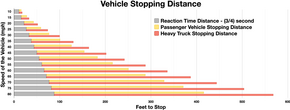Following distance
It has been suggested that this article be merged into Assured clear distance ahead. (Discuss) Proposed since May 2024. |

Following distance is the space between the back of a vehicle and the front of the following vehicle in traffic.
National recommendations
[edit]Australia
[edit]In the Australian state of New South Wales, 3 seconds of following distance is recommended.[1] In Queensland,[2] Victoria,[3] and Western Australia,[4] 2 seconds is recommended.
Europe
[edit]In the European Union, the two-second rule is recommended, and in some European countries there are penalties for maintaining lower distances.[5]
United Kingdom
[edit]In the UK, it is recommended that 2 seconds of following distance is maintained.[6]
United States
[edit]
In the US, for safety it is recommended that 3-4 seconds of following distance is maintained.[7] Extra time should be added for wet, rainy, slippery, foggy or other weather situations accordingly.[8] For heavy duty commercial vehicles it is recommended 4-6 seconds following distance for speeds under 30 mi/h (48 km/h), and 6-8 seconds following distance for speeds over 30 mi/h (48 km/h).[9] Rear-end collisions are the number one type of traffic collisions.[10]
See also
[edit]- Assured clear distance ahead
- Braking distance
- Hydroplaning
- Road collision types
- Tailgating
- Two-second rule
References
[edit]- ^ NSW, Transport for (20 April 2021). "Safe stopping distance | NSW Government". www.nsw.gov.au.
- ^ "Safe following distances | Road rules for everyday driving". www.qld.gov.au.
- ^ "Safe driving tips : VicRoads". Retrieved 31 January 2024.
- ^ "More road rules and penalties". www.wa.gov.au. 7 November 2023.
- ^ "Safe distance between vehicles". Conference of European Directors of Roads. Retrieved 31 January 2024.
- ^ "National Highways urges drivers to use the two-second rule in new campaign". GOV.UK.
- ^ "Proper Following Distance". Pinellas Driving School.
- ^ "Following Too Closely". FMCSA. 15 October 2007. Retrieved 31 January 2024.
- ^ "Free Business Flashcards about UPS Training (Full)". www.studystack.com. Retrieved 31 January 2024.
- ^ Rear end crashes are most common type of collisions azdot.gov
